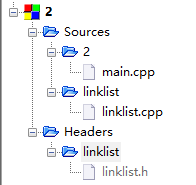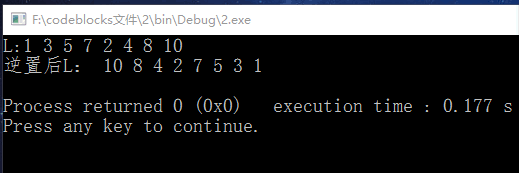/*
*Copyright ? 2017, 烟台大学计算机与控制工程学院
*All rights reserved.
*文件名称:main.cpp
*作 者:黎兆阳
*完成日期:2017年9月26日
*版本号:v1.0
*
*问题描述:单链表:逆置、连接与递增判断
*输入描述:
*程序输出:见截图
*/ 单链表:逆置、连接与递增判断:
1、设计一个算法,将一个带头结点的数据域依次为a1,a2,…,an(n≥3)的单链表的所有结点逆置,即第一个结点的数据域变为an,…,最后一个结点的数据域为a1。实现这个算法,并完成测试。
工程截图:
main.cpp:
#include <stdio.h>
#include <malloc.h>
#include "linklist.h"
void Reverse(LinkList *&L)
{
LinkList *p=L->next,*q;
L->next=NULL;
while (p!=NULL) //扫描所有的结点
{
q=p->next; //让q指向*p结点的下一个结点
p->next=L->next; //总是将*p结点作为第一个数据结点
L->next=p;
p=q; //让p指向下一个结点
}
}
int main()
{
LinkList *L;
ElemType a[]= {1,3,5,7, 2,4,8,10};
CreateListR(L,a,8);
printf("L:");
DispList(L);
Reverse(L);
printf("逆置后L: ");
DispList(L);
DestroyList(L);
return 0;
}
2、已知L1和L2分别指向两个单链表的头结点,且已知其长度分别为m、n,请设计算法将L2连接到L1的后面。实现这个算法,完成测试,并分析这个算法的复杂度。
main.cpp:
#include <stdio.h>
#include <malloc.h>
#include "linklist.h"
void Link(LinkList *&L1, LinkList *&L2)
{
LinkList *p = L1;
while(p->next != NULL) //找到L1的尾节点
p = p->next;
p->next = L2->next; //将L2的首个数据节点连接到L1的尾节点后
free(L2); //释放掉已经无用的L2的头节点
}
int main()
{
LinkList *A, *B;
int i;
ElemType a[]= {1,3,2,9};
ElemType b[]= {0,4,7,6,5,8};
InitList(A);
for(i=3; i>=0; i--)
ListInsert(A, 1, a[i]);
InitList(B);
for(i=5; i>=0; i--)
ListInsert(B, 1, b[i]);
Link(A, B);
printf("A:");
DispList(A);
DestroyList(A);
return 0;
}
3、设计一个算法,判断单链表L是否是递增的。实现这个算法,并完成测试。
main.cpp:
#include <stdio.h>
#include <malloc.h>
#include "linklist.h"
bool increase(LinkList *L)
{
LinkList *p = L->next, *q; //p指向第1个数据节点
if(p != NULL)
{
while(p->next != NULL)
{
q = p->next; //q是p的后继
if (q->data > p->data) //只要是递增的,就继续考察其后继
p = q;
else
return false; //只要有一个不是后继大于前驱,便不是递增
}
}
return true;
}
int main()
{
LinkList *A, *B;
int i;
ElemType a[]= {1, 3, 2, 9};
ElemType b[]= {0, 4, 5 ,6, 7, 8};
InitList(A);
for(i=3; i>=0; i--)
ListInsert(A, 1, a[i]);
InitList(B);
for(i=5; i>=0; i--)
ListInsert(B, 1, b[i]);
printf("A: %c\n", increase(A)?'Y':'N');
printf("B: %c\n", increase(B)?'Y':'N');
DestroyList(A);
DestroyList(B);
return 0;
}


























 266
266

 被折叠的 条评论
为什么被折叠?
被折叠的 条评论
为什么被折叠?








